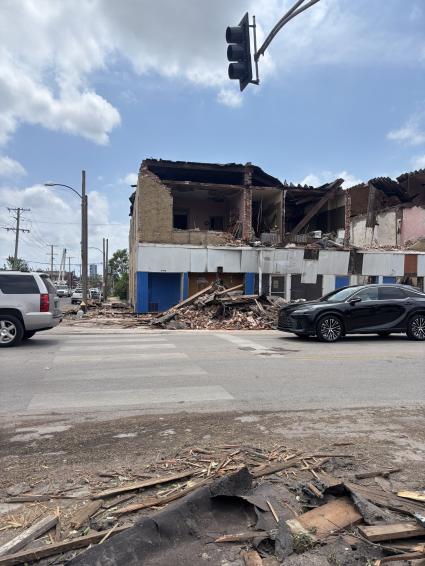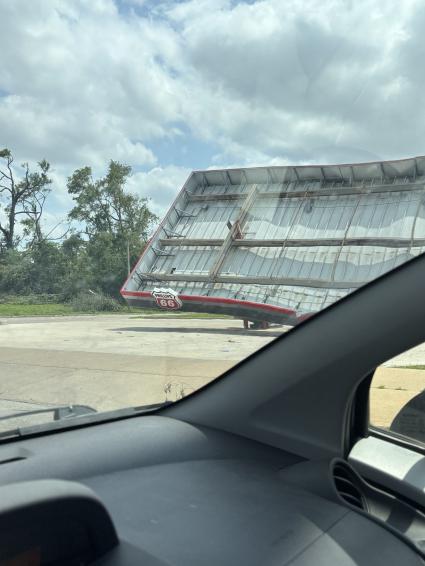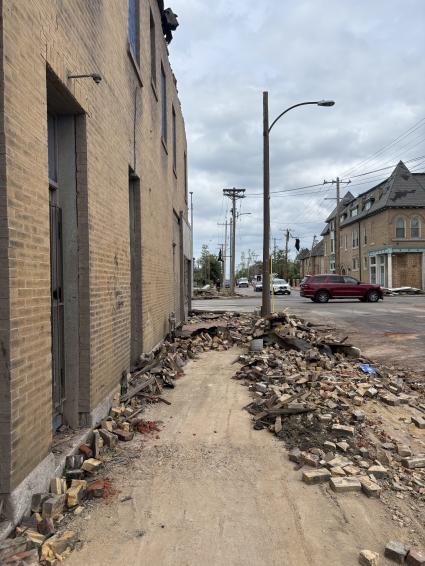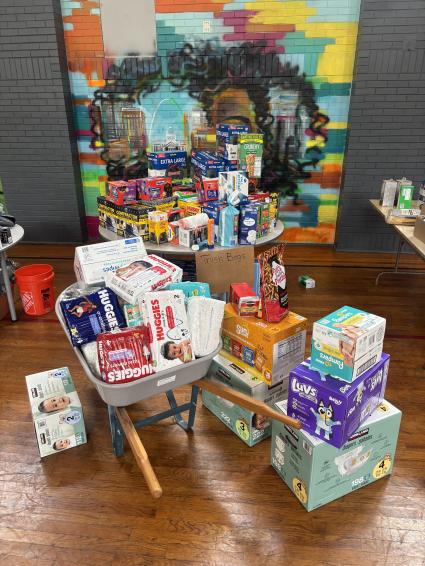Editor’s note: To donate to St. Louis’s tornado relief efforts, please visit ActionSTL, LoveTheLou, the Urban League of St. Louis, the St. Louis Community Foundation, or any of the organizations listed here.
Stacy was on the phone with a friend on the second floor of her St. Louis home when the tornado hit.
There had been an alert from the weather service bleating in the background of the call, but because the outdoor sirens hadn’t sounded — the mayor would later announce that simply no one had pushed a button to set them off — she assumed it was only a warning, that she still had time to make it to the basement. A lifelong Midwesterner, she was used to the storm notifications, the sky growing suddenly dark at 2:30 p.m.; the rain and the winds might be rough, but usually, the storm would pass quickly.
“Then I heard the windows start shaking,” she told me. “And I saw the whole wall just come down.”
I’m standing with Stacy where that wall once stood, behind the home on Page Boulevard in the Lewis Place neighborhood, which, until three days ago, she shared with five people. It’s been in the family since her grandmother was a little girl, and her grandmother still lived there last week, though no one but Stacy was home during the storm. Somehow, she was able to make it down two staircases and through the ruins of her home to the basement, where she clung to a support beam until the wind stopped just a few minutes later. (“Who hasn’t seen the movie Twister?” she laughs, explaining where she got the idea.)
Now, her entire family has been displaced to a hotel after what has since proved to be the worst tornado to hit the city since the 1950s. The EF-3 storm whipped 156-mile-per-hour winds through much of the city, killing at least five people — though some locals fear that’s an undercount, since not all homes could be thoroughly searched.
The storm wreaked havoc and knocked out power at businesses and homes throughout the city for days, including mine. But the impacts were the worst on the 99 percent Black and predominantly low-income north side, where decades of racially biased policies and disinvestment had already left thousands of buildings vacant and in varying states of collapse before the storm. Despite those destructive forces, north side neighborhoods have often remained close-knit communities with rich histories and a high concentration of elders; Lewis Place is on the national register of historic places, and played a major role in helping to strike down racially restrictive housing covenants across the country.
Many of the estimated 5,000 structures that were damaged across St. Louis are located in Black neighborhoods like Lewis Place; officials say they will cost more than a billion dollars to repair. And since many families on the north side have owned their homes for generations and don’t have mortgages or insurance, some likely won’t be fixed at all.

The word “damage,” though, doesn’t fully capture the weight of three generations of a family displaced, or a home with an entire wall torn off like skin, tarps slung over furniture to protect what they can from the rain. The word isn’t big enough to hold the blocks and blocks of other buildings just like it, century-old bricks heaped across crabgrass, t-shirts taped up as makeshift curtains where the windows all blew out at once.
Many of these houses are unstable, but they still have people living in them, particularly the elderly, some of whom have been stranded without electricity for days and ask for water when they see someone walk by who looks like they’re willing to help. There are people sleeping on couches on their front lawns, people chainsawing through giant trees to open blocked front doors. Despite not yet receiving an emergency declaration from President Trump — and considering his threats to defund FEMA, some are worried that federal lifeline may never come — it’s undoubtedly an emergency, the kind of story that leaves a neighborhoods looking more like a war zone.
Like everyone I’ll speak to today, I tell Stacy that I’m a journalist as well as a neighbor and volunteer, and that I mostly write about transportation issues. I ask her how she’s getting around since the storm, and she says that she’s lucky to still have her car, because many of her neighbors’ vehicles were destroyed. And most didn’t even have one to begin with.
The census tract where this segment of Page Boulevard is located is above the 98th percentile for households without access to a private vehicle. Other residents will tell me today that the buses have either been cancelled outright or are running on unpredictable routes to avoid dangerous obstacles like downed wires; the streetlights are all out, long lines of car traffic backing up where utility crews spill out over the curbs. Everywhere, the sidewalks are blocked with piles of debris, the air swirling with toxic particulates kicked up from demolished buildings and the soil itself, which no one in their right mind would want to huff on a bike.
A volunteer organizer named Shai Kaye told me that even getting access to the most basic forms of help is an impossible challenge for many residents right now.
“The biggest issue is that we have a lot of hubs that are set up, but people can’t get to them because our public transportation isn’t running normally,” she said. “Not to mention we have no cell service, we have no power — we have nothing down here. People are posting about [volunteers] being posted up on these blocks, but the people who need to see it can’t see it — and if they can’t see it, they can’t get to it. They don’t know it exists.”
Despite having a car, Stacy is still overwhelmed. She makes me a long list of the things she needs that she’s struggling to find: flashlights with batteries to pack up a crumbling house in the dark, contractor bags and boxes to save what she can.
I could, if I wanted, draw a fairly straight line between what’s happening to my city right now and the culture of car dependency I write about every day.
Passenger cars, after all, are the leading polluter in the transportation sector, which is itself the greatest driver of climate change, increasing the frequency of Missouri’s tornados even in dense urban areas where storms usually break up. People are afraid to walk on Page Boulevard even in normal times, since it’s a wide, fast road that’s claimed the lives of five pedestrians and cyclists in the last four years; I cannot blame them for getting in a car with an airbag and a better chance at survival in a crash, at least if they have the chance.
But as I drive to the volunteer hub to get Stacy the supplies she needs, pulling over to take photos of a gas station awning crumpled like an aluminum napkin, I start to question whether I can write about what I’ve seen here today through my normal lens.

Can I complain, right now, about how hard it is to walk in most cities when it takes me and a crew of 12 other volunteers half an hour to clear the remains of a shattered roof off a single, six-foot stretch of sidewalk — one of thousands of blocked pedestrian walkways that are filled with debris?
Should I really be writing public transportation when people might still be trapped in their homes, calling out for water?

The truth is, it is unethical to write about car dependence in a vacuum — and not only in the aftermath of a terrible storm.
Transportation advocacy should shift in response to the context and community in which we’re advocating, to put ourselves directly in service of what residents tell us they need — and not what we think they need, or what we want. In the immediate aftermath of a tornado, it is tactless push bike lanes and bus funding, when residents are crying out for caravans full of contractor bags and coolers full of insulin.
I’d argue, though, that by adopting a different frame for our transportation reform advocacy, we will return to shared and active transportation — albeit as tools, rather than our goal itself. And that starts with understanding what we’re really fighting against.
In some ways, what is most toxic about our dominant transportation culture is not cars, or highways, or the emissions that spew out of our tailpipes, but a hyper-individualism that insists that policy should never stand in the way of our individual freedom to move whenever we want, as fast as we wish — even if the exercise of that freedom constantly kills our neighbors in crashes, bankrupts our most desperately-struggling communities of money and opportunity, and ultimately, dooms our entire species.

But what if we demanded a humane transportation culture, where the goal of policy is to give more residents more options to navigate and thrive in the world — and in the process, to make that world less horrifyingly and constantly violent?
This is a framework that would be flexible even in the face of a deadly tornado, shifting to provide free caravans of supplies while neighbors are racing to salvage what’s left of their belongings — and shifting to provide those same neighbors an affordable bus line the instant roads are clear, even if that means making it free for the poorest among us.
This is a framework that would not accept car crashes or natural disasters as inevitable, much less the cascade of devastation that follows when those horrors happen to our most vulnerable communities — and take collective action to prevent them right now, rather than leaving it to those communities to literally pick up the pieces.
And most of all, this is a framework that would recognize that even as car dependency shapes and alters so much of our lives, it is only one thread in a tapestry of violent power structures that we must unravel — and that makes our work more important, not less.

When I asked Shai Kaye what she wanted the nation to know about what’s happening in the aftermath of St. Louis’s tornado, she did not focus on its transportation challenges. She emphasized the need for volunteer construction expertise to repair homes quickly, so they’re not acquired by the state under eminent domain or sold to landbankers for far less than they’re worth to the communities that value them most. She stressed the need to keep residents in homes their families have often owned for generations, and to finally invest in a region that was experiencing a slow demolition by neglect long before the storm.
“This is home for me,” she said. “It’s important for me to make sure that the people who don’t know how to ask for help get the help that they need, that people who need help don’t feel as though their dignity is shot at because they need help. [It’s important to make] sure that the right resources are in the right places.
“The issue with a lot of the larger organizations that I have come across is they have to stick to certain guidelines, rules and regulations, and that limits their ability to be able to assist and help those that are most in need,” she added. “I’m not limited by anything.”
If we are wise enough to listen to people like her, and Stacy, and everyone else who is on the losing end of these systems that govern our lives, our advocacy can be just as limitless.

